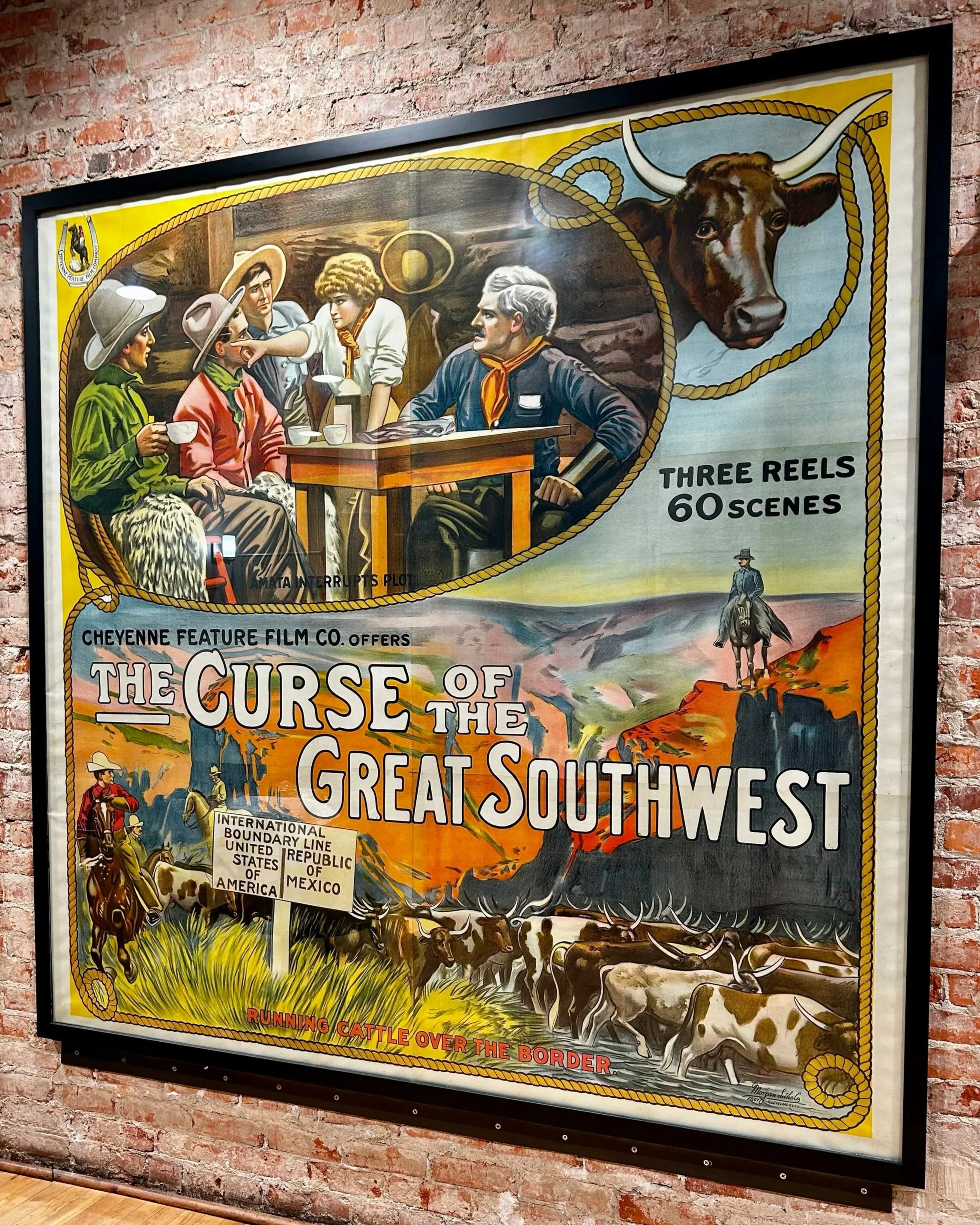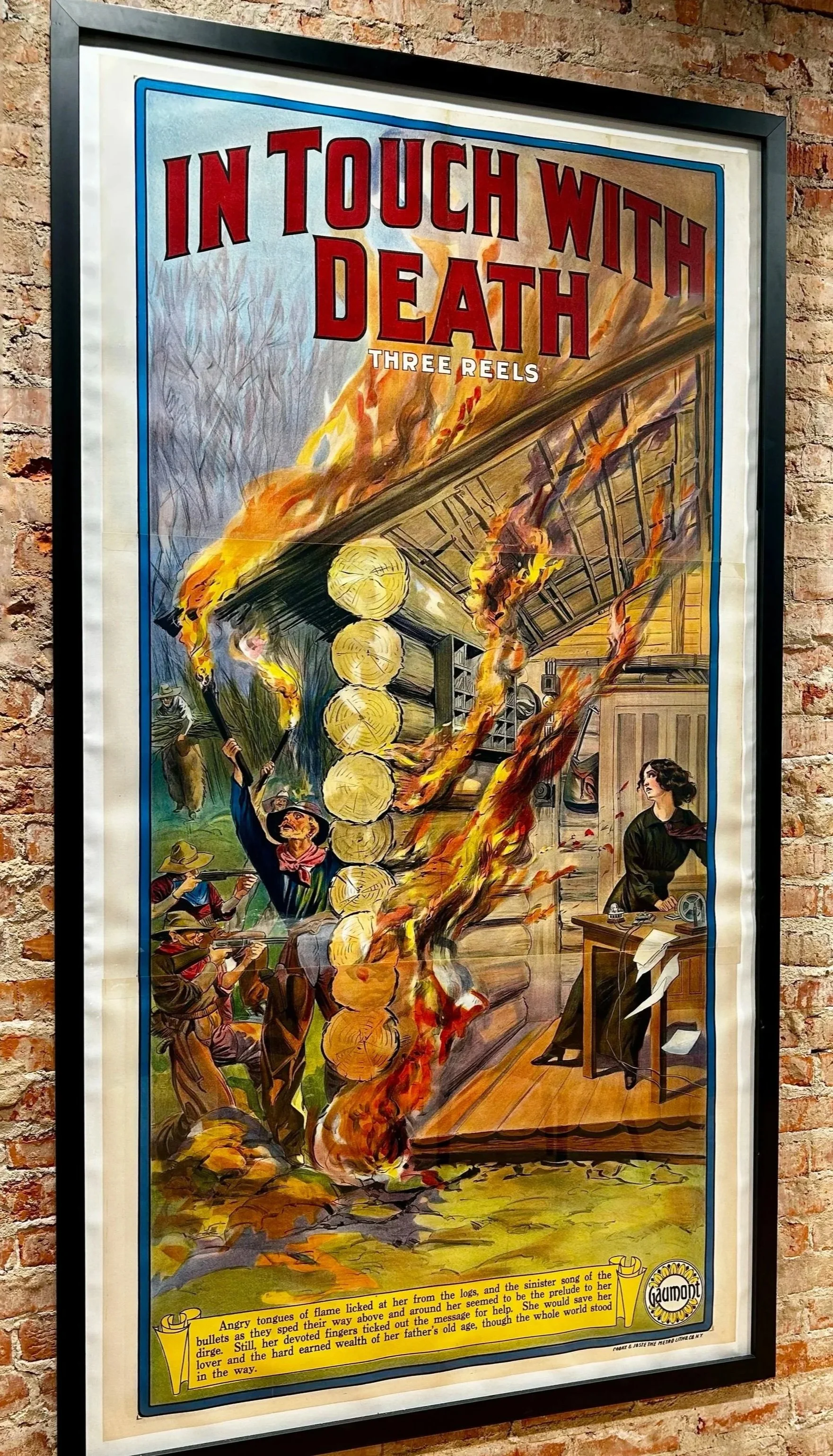The Silent Frame Exhibit at Robinson Film Center
During the formation of the board and building committees of RFC (2005) individual poster sheets were given by the family of Howard Clinton Belcher, Jr. to Marion Marks in anticipation of preservation and display at a future date at RFC. The poster sheets were archived since 2005 in acid-free binders and shipped to Chicago in 2023 for conservation. They were washed, bleached, mounted on linen and canvas, rebuilt with filler & paint, framed in Shreveport and placed on display by the Marks family & MMCC Forensic. These are the only known posters of these silent movies known to exist.
With the remodeling of RFC, the posters were sent for conservation, and display was planned outside of Abby Singer’s Bistro. Poster and print restoration is a difficult process that is necessary for museum documents and art displays, even when objects may appear to be in pristine condition. The following video gives insight into the process:
The movie poster is thought to have originated in the 1870s when Paris artist and lithographer, Jules Cheret, introduced a printing technique that produced images with intense color and rich texture. By the early 1890s, Paris streets were plastered with lithographic images hawking everything from bicycles to cognac to circus performances. These artful graphics became instant collectables, spawning exhibitions, journals and dealers. The first promotional movie poster was created in 1895 for the French short L’Arroseur Arrosé, the earliest known fictional comedy film. Since the early cinemas only had one screen to show a single film, displaying posters outside the theater became integral to generating word of mouth and interest in the production.
Movie posters historically served as a bridge between the audience and the cinematic experience. Their primary role in film publicity has been to distill the essence of a film into its most persuasive visual signs—its adventure, stars, and drama—to entice passersby off the street and into the theater. Among their earliest instances, posters portrayed the act of watching a film itself, incorporating elements such as projectors, operators and motion picture images to demystify this new entertainment technology.
Early Hollywood movie posters were heavily influenced by ads made for traveling entertainment, like circuses. The main style through the end of the 1940s featured an illustrated scene or characters from the film. Then the ‘50s and ‘60s posters saw an increase in conceptual, abstract, and minimalist designs. Photographs began to take over illustrations in the ‘70s, which led to today’s modern film poster style that rose to prominence in the 1980s.
Today’s cinema owes an enormous debt to the pioneering filmmakers of the silent period. You can find virtually every cinematic style and genre in the artistic roots of the silent era. Experiencing a movie will create the same impact of the early experiments that preceded the “talkies”. Film aficionados should consider researching these films for many reasons.
Misconceptions about silent movies too often dissuade audiences and students from indulging in their magical powers. The terminology ‘silent movie’ is a misnomer as live music almost always accompanied the visuals. Yes, no sync sound dialogue appears in these films, but the musical component that was the accompaniment contributed to the viewing experience. Intertitle cards clarified the dialogue and essential plot points.
Visual quality of the silent movie may appear primitive by today’s standards, yet many silent movies have maintained the highest quality available at the time if the film stock was properly preserved. The cultural and historical significance of silent movies documented mores of the day, and they delighted and entertained as much as contemporary movies!
Cinema paralleled and visually led period movements, including German Expressionism (which influenced horror and film noir), French Impressionism, Italian Neorealism, Soviet Montage, and Classical Hollywood. Europe represented the majority of innovation in moving pictures until World War I, when Hollywood began to lead.
A horse and a jockey starred in the first “film”. British photographer Eadweard Muybridge changed the course of photography with his ground-breaking work in photographic studies of motion. The iconic, The Horse in Motion (1878) was a series of 11 still photographs projected at speed to simulate a motion picture. This innovation from still photography was to discover whether all of the horse’s hooves left the ground simultaneously when galloping. And, it was a marvel to all who experienced it.
With the pioneering technological inventions of the zoopraxiscope (one of the earliest predecessors to the movie projector), the Kinetoscope, and later the Lumière Brothers Cinematograph, the art of motion pictures grew exponentially. 1895 is generally accepted as the beginning of the silent movie era, with the height of creativity and innovation between 1910 and 1929.
In the early years, the fascination was centered on the technological capabilities of the medium and its ability to visually represent the real world. La Sortie de l'Usine Lumière à Lyon (The Workers Leaving the Factory, 1895), the Lumière Brothers' first film, is simply a 46-second one-shot film showing workers leaving the Lumière factory. These early slice-of-life films were revolutionary for the time – never had the public seen such realistic representations of the lives they lead.
So realistic in fact, that during the first screening of the Lumière short L'arrivée d'un train en gare de La Ciotat (The Arrival of a Train at La Ciotat Station) in 1986, the audience members were so shocked at the moving image of the life-sized train coming towards them that many screamed and ran to the back of the room. Or so the urban legend goes. These films were the early examples of actualités or actuality films, and prototypes for the creation of the documentary.
On the flip side of the fascination with realism, other filmmakers saw the potential of cinema to tell stories and transport audiences to other worlds. This curiosity birthed what was later coined by film researcher Tom Gunning, the cinema of attraction (Europeana). The likes of Spanish filmmaker Segundo de Chomón and, most famously, French director George Méliès developed many technical and narrative techniques. They were among the first to utilize special effects in the form of substitution splices, multiple exposures, time-lapse photography, dissolves, and hand-painted color. Widely credited as the first science fiction film ever made, Le Voyage dans la Lune (A Trip to the Moon, 1902) by Méliès drew on famous works by H.G. Wells and Jules Verne to depict a spacecraft being launched into the moon.
The vaudeville aesthetic in these films was shared by emerging comedies. The popularity of slapstick comedy sky-rocketed with the likes of Buster Keaton, Harold Lloyd, and Charlie Chaplin taking center stage. The General (1924), Safety Last! (1923), and The Kid (1921) are examples of their iconic comedies. This vaudevillian style inspired shock and awe and, most importantly, laughs.
Along with the development of comedy, telling stories with the view to immerse and captivate flourished, bringing with it the emerging language of narrative. Edwin S. Porter’s The Great Train Robbery (1903) was an early example of this new action-driven narrative. D.W. Griffiths, Fritz Lang, F.W. Murnau, Alice Guy-Blache, Cecile B. DeMille and so many more contributed greatly to the constitution of the cinematic language. It would be an unadulterated tragedy for the glory of silent cinema to be forgotten. The silent period birthed many facets of the language of cinema we know, and love, today.


